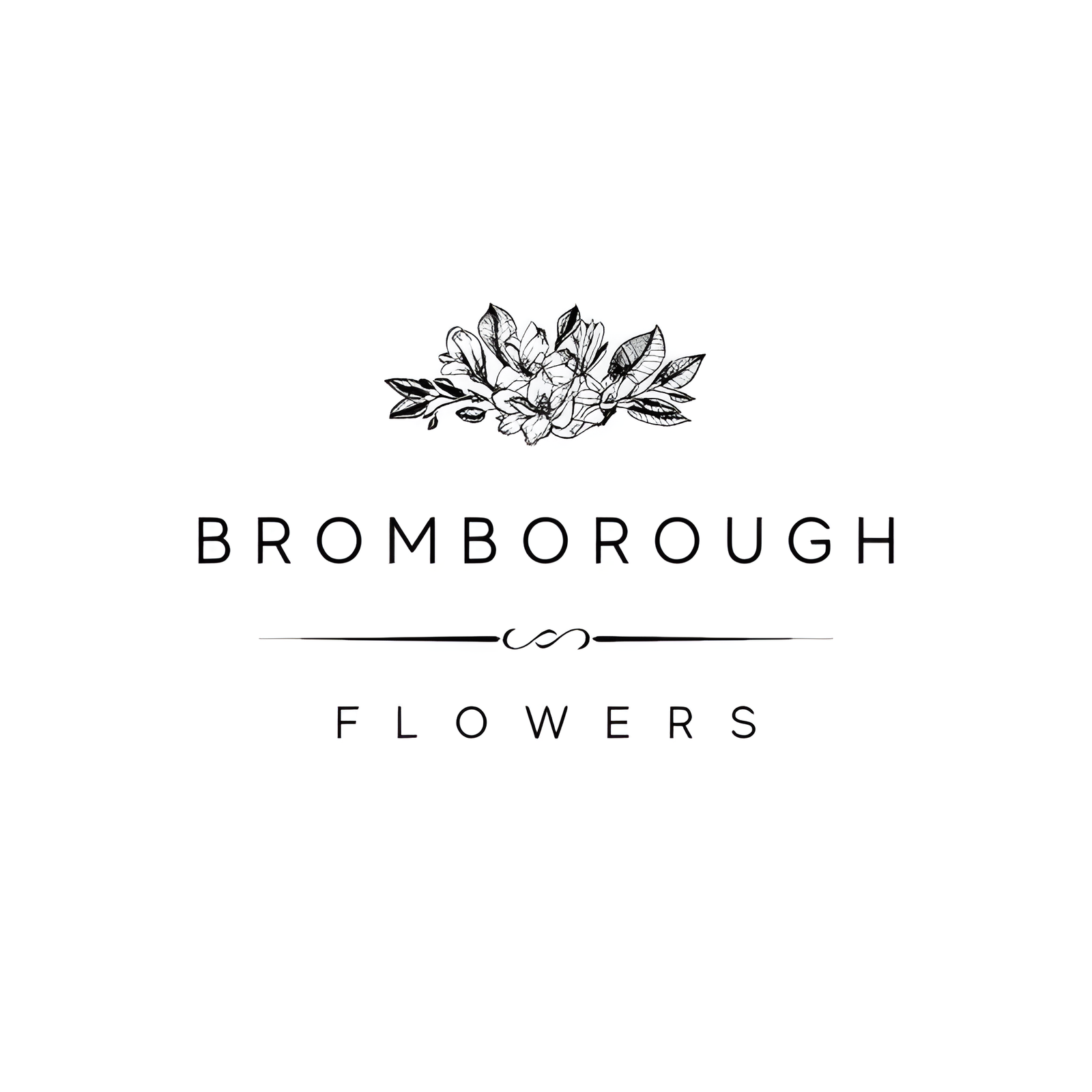The Dianthus, or Carnation, stands out as a quintessential choice for wedding floral arrangements, embodying both elegance and resilience. Known for its ruffled petals and diverse color palette, this flower offers not only aesthetic appeal but also a rich tapestry of meanings, including love, purity, and admiration. Its robust nature makes it ideal for various wedding elements, from bouquets to boutonnieres. As we explore the multifaceted characteristics and cultural significance of the Carnation, you’ll discover why this bloom remains a timeless favorite among couples planning their special day. What makes the Carnation’s versatility so compelling?
Flower Overview
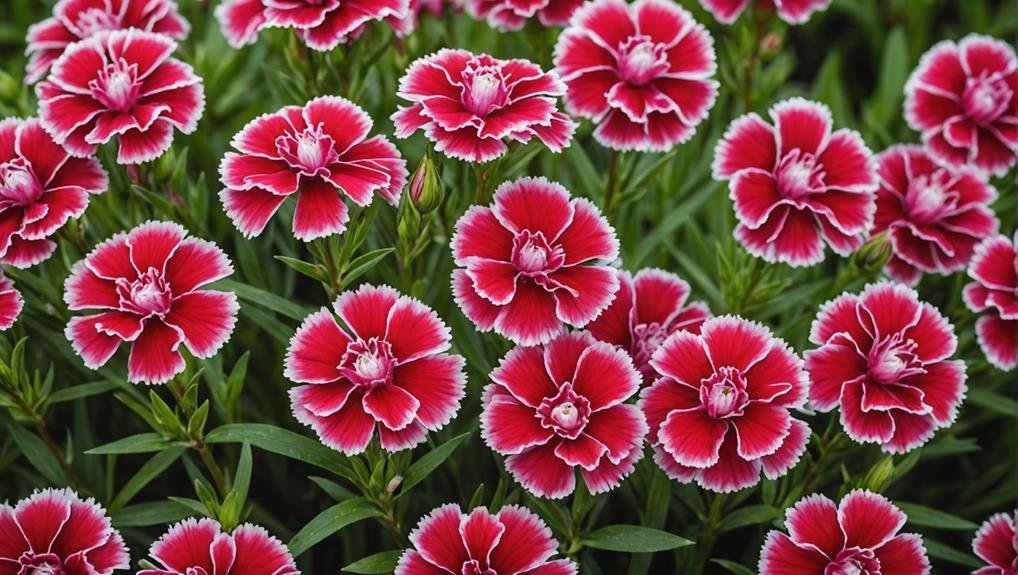
Dianthus, commonly known as Carnation, is a sturdy and adaptable flower perfect for a wide range of wedding arrangements. Recognized for their resilience and toughness, carnations are a popular choice for wedding bouquets, centerpieces, boutonnieres, and corsages. This flower’s long-lasting nature guarantees that wedding decorations stay fresh and vibrant throughout the celebration.
Carnations are highly prized for their extensive color range, which includes tones of pink, red, white, yellow, and more. This variety enables them to seamlessly complement any wedding theme or color scheme. Moreover, carnations are easy to manipulate; their petals can be fluffed up to add texture and volume to floral designs. By pressing the petals open, florists can create fuller, more dynamic arrangements that enhance the overall aesthetic.
As fundamental components in floral arrangements, carnations serve as excellent filler flowers. Their capacity to uphold structure and form under various conditions makes them a dependable choice for any wedding setting. The combination of their beauty, adaptability, and resilience guarantees that carnations remain a cherished option for brides and wedding planners alike, contributing to memorable and visually stunning celebrations.
Physical Description
Characterized by their ruffled petals and a wide range of vibrant colors, carnations are easily recognizable and highly valued in wedding floral arrangements. Carnation flowers, known scientifically as Dianthus, are celebrated for their large, eye-catching blooms, with some varieties reaching up to six inches in diameter. This makes them a striking choice for various wedding elements, from bridal bouquets to centerpieces.
Their unique petal structure, often described as ruffled or frilled, adds texture and dimension to any arrangement, enhancing the visual appeal. The petals are densely packed, creating a lush, full appearance that complements both classic and contemporary wedding themes. Additionally, the long-lasting nature of Dianthus carnations ensures that they stay fresh and vibrant throughout the wedding day, making them a reliable option for DIY wedding flowers.
Not only are they visually appealing, but carnations are also easy to care for, which is a significant advantage for those looking to create their own wedding floral arrangements. Their sturdy stems support the large blooms effectively, allowing for versatile use in various floral designs, including corsages and boutonnieres.
This versatility and ease of use contribute to their enduring popularity in the world of wedding floristry.
Available Colour Varieties
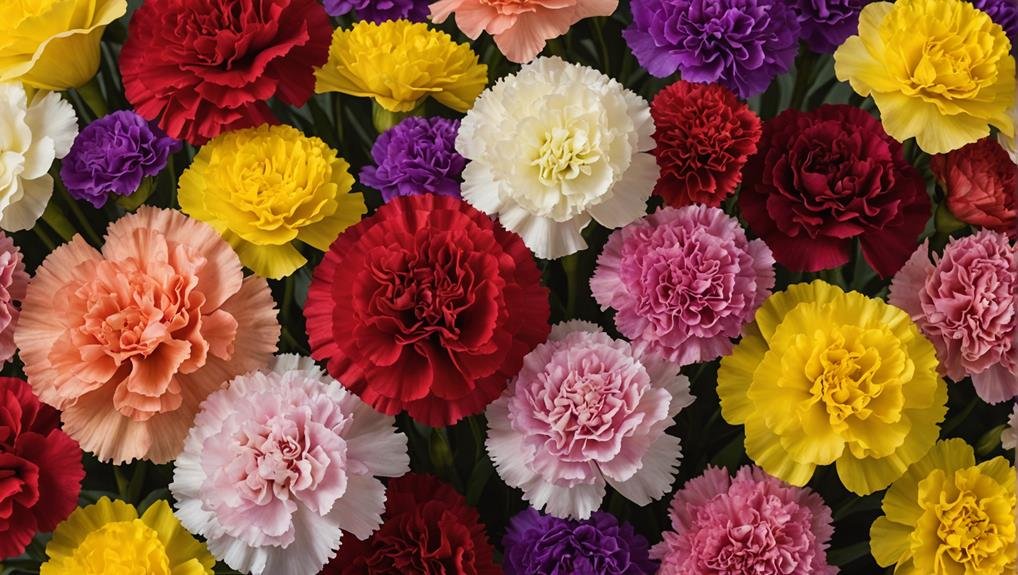
A kaleidoscope of colors awaits with carnations, offering a spectrum from soft pastels to vibrant hues that can seamlessly blend into any wedding theme. These Wedding Flowers are celebrated for their broad Color Varieties, which include shades like pink, red, purple, white, green, yellow, and even striped versions. This extensive color palette allows couples to select carnations that perfectly match their wedding decor and personal style.
Carnations’ color versatility is not just visually appealing but also symbolically rich. For instance, pink carnations often symbolize gratitude and love, while white ones denote purity and luck. This means that beyond their aesthetic value, carnations can imbue your wedding with deeper layers of meaning.
To further illustrate the range of carnations available, consider the following table showcasing some of the popular color options and their symbolic meanings:
| Color | Symbolism | Wedding Theme Suitability |
|---|---|---|
| Pink | Gratitude, Love | Romantic, Classic |
| Red | Deep Love, Admiration | Passionate, Bold |
| White | Purity, Luck | Elegant, Traditional |
| Purple | Capriciousness | Unique, Modern |
| Green | Health, Good Fortune | Nature-inspired, Contemporary |
| Yellow | Joy, Friendship | Cheerful, Casual |
This array of Color Varieties guarantees that carnations can be tailored to enhance any wedding vision, making them a versatile and elegant choice for your special day.
Latin Name and Taxonomy
Understanding the botanical specifics of carnations enriches our appreciation of their diverse color palette and symbolic meanings. The Latin name for the carnation is Dianthus caryophyllus, a designation deeply rooted in classical language, derived from the Greek words ‘dios’ meaning divine and ‘anthos’ meaning flower. This nomenclature aptly reflects the flower’s esteemed status across various cultures and occasions.
Taxonomically, carnations belong to the family Caryophyllaceae, a large group of flowering plants known for their notable beauty and fragrance. The genus Dianthus comprises numerous species, each with unique characteristics, growing habits, and flower colors. Key species within this genus include Dianthus barbatus (commonly known as Sweet William), Dianthus grataniapolitensis, and Dianthus chinensis (Chinese Pink), among others. Each species contributes to the rich diversity found within the Dianthus genus, offering various options for florists and wedding planners.
Carnations are distinguished by their colorful, fragrant blooms, which are often used in floral arrangements and bouquets. While their native range spans Europe, Asia, and Africa, their adaptability has allowed them to flourish in various climates, further enhancing their popularity in wedding floral designs.
Through understanding their Latin name and taxonomy, one gains a deeper insight into the botanical elegance of carnations.
Geographical Origins
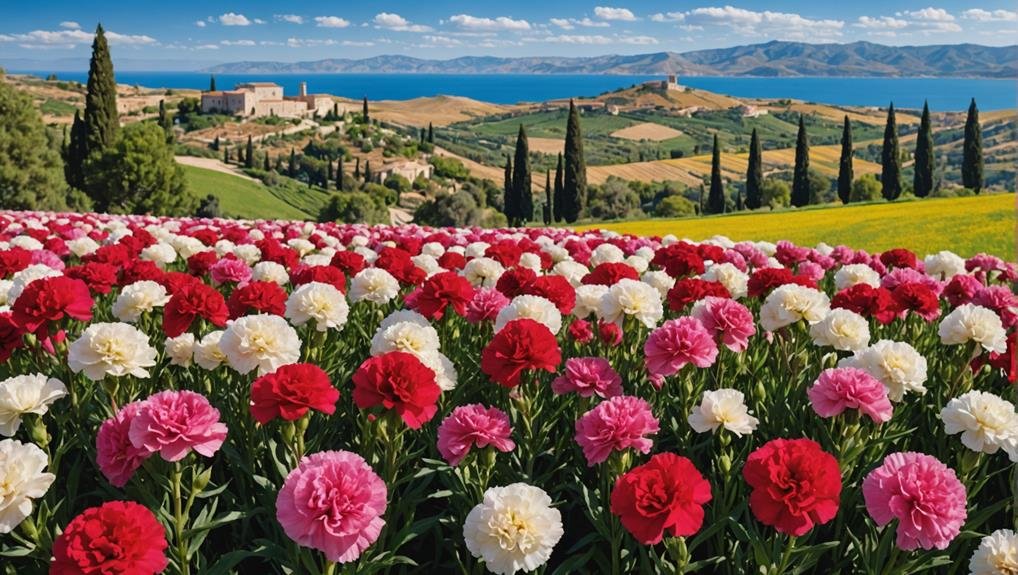
Dianthus species, commonly known as carnations, originate from a diverse range of geographical regions including Europe, Asia, and Africa. This wide distribution has contributed to the plant’s versatility and adaptability, making it a popular choice for various horticultural and ornamental purposes.
Dianthus caryophyllus, often referred to as the common carnation, is native to the Mediterranean area, specifically Greece and Italy. Meanwhile, Dianthus barbatus, known as Sweet William, can be traced back to southern Europe. Another distinct species, Dianthus gratianopolitanus, also known as Cheddar Pinks, is indigenous to central and western Europe. In contrast, Dianthus chinensis, or Chinese Pinks, originally hails from China and has successfully adapted to different climates, thriving in various parts of the United States.
The geographical origins of Dianthus species underscore their adaptability and resilience:
- Dianthus caryophyllus: Native to Greece and Italy
- Dianthus barbatus: Found in southern Europe
- Dianthus gratianopolitanus: Indigenous to central and western Europe
- Dianthus chinensis: Originates from China
- Adaptability: Thrives in diverse climates, including regions in the US
Understanding these origins offers valuable insights for selecting and cultivating Dianthus in various environmental conditions, ensuring their successful integration into wedding floral arrangements.
Season Availability
Thanks to their ability to bloom from early spring to mid-fall, carnations are available year-round, providing a reliable choice for wedding floral arrangements regardless of the season. This extended blooming period offers flexibility for wedding planners and florists, making sure that couples can rely on these vibrant flowers no matter the date of their special day.
Carnations thrive in Full Sun, a factor that contributes to their robust growth and consistent availability. Their adaptability to various climates and growing conditions guarantees that they remain a staple in the floral industry. Whether used as the main attraction or as a complementary Ground Cover, carnations add a touch of elegance and charm to any wedding setting.
The wide range of colors available, including green, pink, red, and white, allows for seamless integration into any wedding theme. The varied types of Dianthus, such as Cheddar Pinks and Sweet Williams, further broaden the options for unique and personalized floral designs. This variety ensures that florists can create intricate and customized arrangements that perfectly suit the aesthetic preferences of the bride and groom.
Growing Conditions
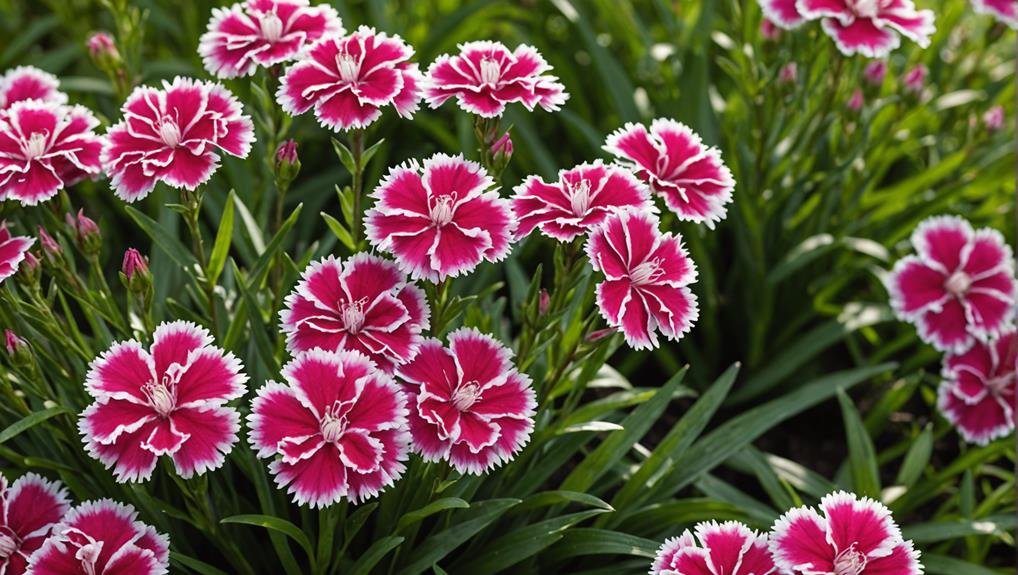
For best growth, carnations require full sun to part shade, ensuring they receive at least four hours of sunlight daily. This condition is essential for their peak development, promoting robust blooms and healthy foliage. Dianthus (carnations) are known for their resilience, being drought-resistant and hardy, which makes them an excellent choice for gardeners and DIY flower enthusiasts alike.
Proper growing conditions for these versatile flowers include:
- Soil: Well-drained soil enriched with organic matter is ideal.
- Watering: Moderate watering is vital, allowing the soil to dry out between waterings to prevent root rot.
- Fertilization: A balanced fertilizer applied during the growing season can enhance growth and blooming.
- Deadheading: Regularly removing spent flowers encourages more blooms and extends the flowering period.
- Air Circulation: Ensuring good air flow around the plants helps prevent diseases.
Dianthus can reach heights of 9-12 inches and widths of 7-12 inches, making them suitable for beds, borders, containers, and ground cover. Their long blooming season from early spring to mid-fall provides ample opportunities for use in cut flowers and wedding arrangements, adding vibrant color and texture.
Cultural Significance
Carnations have long held a prominent place in various cultural traditions, symbolizing a range of emotions from love and admiration to purity and luck. Their rich cultural significance makes them an ideal choice for a carnation wedding, where these symbolic meanings can enhance the atmosphere and emotional resonance of the event.
In Spain and Croatia, carnations are deeply associated with Mother’s Day, often given as heartfelt gifts to express gratitude and admiration. This tradition underscores the flower’s role in familial love and respect.
Similarly, in Korea, red and pink carnations are customary gifts to convey admiration and gratitude, particularly towards parents and elders.
Carnations are also the birth flower for January, representing affection and admiration—a fitting tribute for any celebration of love and commitment.
Across different cultures, the carnation’s symbolism of love, purity, luck, and admiration makes it a versatile and meaningful addition to any ceremonial décor.
Typical Use in Weddings
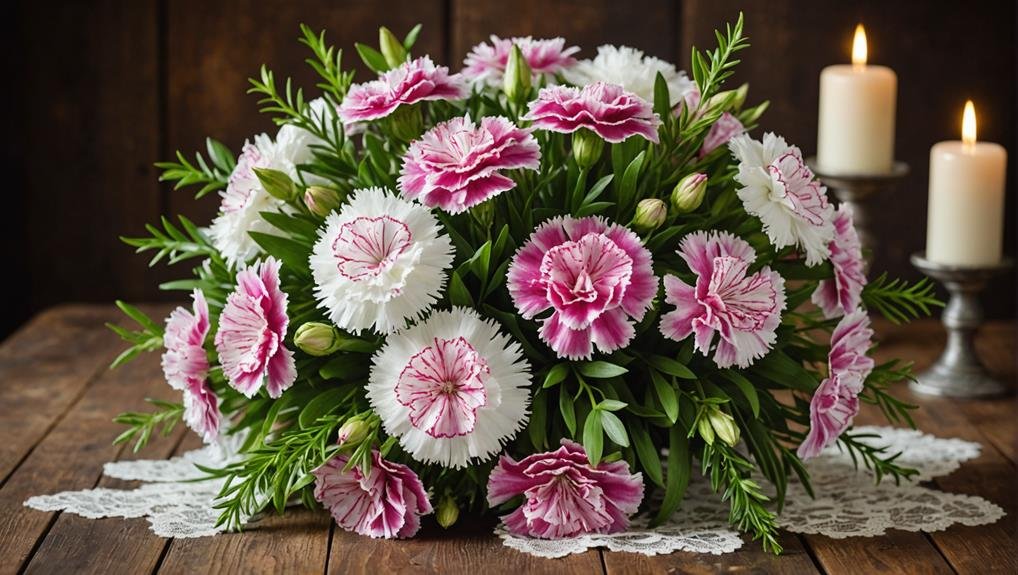
Dianthus, commonly known as carnations, play a significant role in weddings, frequently featured in bouquets, boutonnieres, corsages, centerpieces, and large floral arrangements. Their hardiness and durability make them ideal for various wedding floral designs, ensuring that they maintain their appearance throughout the event. The consistent color and long-lasting nature of carnations make them a popular choice for many couples.
Carnations serve as a perfect foundational element in wedding floral arrangements. Their versatility allows them to be creatively manipulated, such as by pressing the petals open, which adds a unique touch to any arrangement. For those interested in a DIY approach to wedding flowers, carnations offer both ease of use and adaptability.
- Bouquets: Carnations are often used in bridal and bridesmaid bouquets due to their vibrant colors and sturdy nature.
- Boutonnieres: Their durability makes them a reliable choice for boutonnieres, ensuring they last throughout the special day.
- Corsages: Carnations are frequently chosen for corsages because they can withstand handling and remain fresh.
- Centerpieces: As a long-lasting flower, carnations are ideal for table centerpieces, providing beauty throughout the event.
- Large Arrangements: Their availability in various colors and forms makes them suitable for grand floral displays.
Alternative Flower Types
While dianthus remains a popular choice for wedding flowers, exploring alternative flower types can provide diverse aesthetics and unique textures for your arrangements. Roses, dahlias, peonies, and hydrangeas are excellent substitutes, each bringing its own charm and elegance.
Roses, with their timeless appeal, offer a wide array of colors and symbolize love and romance. Dahlias, with their intricate petal structures, add depth and complexity to any bouquet. Peonies, known for their lush and full blooms, are perfect for creating a soft, romantic look.
Hydrangeas, on the other hand, provide volume and can be used to create a lush, opulent feel. Other alternative flower types include lilies, sunflowers, tulips, and ranunculus, which offer vibrant colors and unique textures.
For those seeking more exotic options, orchids and calla lilies provide a sophisticated touch, while gerbera daisies and anemones add a playful, yet elegant, flair. Chrysanthemums, asters, lisianthus, and snapdragons also serve as excellent substitutes, offering diverse shapes and colors.
Seasonal blooms like irises, lilacs, marigolds, and delphiniums can further personalize your wedding arrangements, ensuring each floral display is both unique and memorable.
